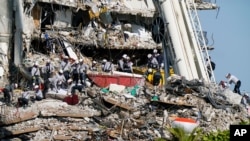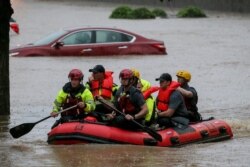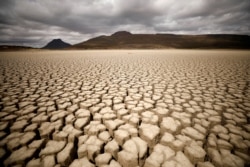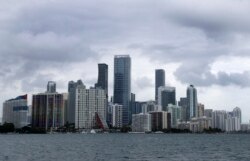Last week, a 12-story apartment building suddenly collapsed in a Miami, Florida, suburb, killing at least 11 people and leaving some 150 others missing. While the cause of the disaster is unclear, rising sea levels that flood parts of the Miami area with salt water and regularly left standing water in the underground garage of the Champlain Towers suggest that climate change played a role.
Meanwhile, more than 4,000 kilometers away, residents of Seattle, Portland, and the rest of the U.S. Pacific Northwest endured a fourth consecutive day of a record-setting heatwave.
Roadways are buckling as asphalt melts and separates from the ground, making them impassable. Rubberized coatings that protect electrical wiring on mass transit systems are melting, forcing authorities to shut them down until repairs are made.
In the United States, people generally take it for granted that buildings will maintain their structural integrity, roadways don’t turn to molten sludge and mass transit systems keep functioning. For many, recent events may shake those assumptions.
Nobody is ready
It is becoming increasingly clear that how Americans expect society to function within different ecosystems is changing — sometimes dramatically. In the Northeastern U.S., what used to be considered “100-year floods” now occur almost annually. In the Southwest U.S., half a dozen states have lived with significant droughts in ten of the past 20 years.
Is the nation adequately prepared for precipitous and increasingly calamitous change? People who make it their business to peer into the future say, unequivocally, America and humanity more broadly are not.
“Nobody is, probably, least of all the U.S. because of prevalent mindsets,” said Richard Hames, executive director of the Centre for the Future, a global organization that “identifies and redesigns life-critical system that are collapsing under the weight of a population now exceeding seven billion people, that are no longer relevant, or that do not yet exist but will be needed for a future we cannot yet comprehend.”
A dystopian vision?
The picture Hames paints of humanity’s near-future is not a pretty one.
“Scientists are now saying that things are beyond the worst-case scenario, we're heading fast to irreversible tipping points, simply because of everything that's locked in already,” he told VOA.
In terms of the climate crisis, Hames said, “there is nothing in human experience” on which we can draw. The entire Holocene Period — the age of the earth in which human civilization arose and flourished — has been marked by a climate that existed in a stable state of conditions conducive to human thriving.
“Now we're in a state of exponential change, which, again, nobody really gets, nobody understands. And know that there's nothing in human experience to [help us] cope with what we're in for.”
Is my home safe?
If humanity is to cope with exponentially increasing effects of climate change, some experts say the first step will have to be truly internalizing the seriousness of the species’ perilous position. That, for example, tragedies like the South Florida building collapse might accelerate.
Bruce Turkel, an author, speaker, and founder of The Strategic Forum in South Florida, was born and raised in Miami. As someone who makes a living helping businesses look into the future of their brands, he says the Champlain Towers collapse is the sort of event that makes people challenge long-held assumptions.
The eastern part of Miami Beach, he notes, is called the “concrete canyon” by locals for the high-rise apartment buildings that line its roads for kilometers of beachfront property.
“Imagine how many buildings there are; multiply that by the number of apartments; multiply that by the average occupancy of each apartment,” Turkel said. “How many people now are wondering, ‘Oh, my God, is my building safe?’”
Virtually all of those people knew, on some level, that climate change was a problem, he said. But far fewer of them perceived it as an existential threat on a personal level.
“If, in fact, climate change affected this building's integrity, we didn't have any perception or understanding that that was an issue,” he said. “What are the unexpected consequences? And how do we deal with those? That's the big, social, and also socio-economic and geopolitical issue. As people start to say, ‘Oh, my goodness, I never thought of that. Oh, my goodness, I didn't know that would happen.’ Where does that lead us?”
Change is coming, but from where?
While few experts doubt that widespread change as a result of the climate crisis is coming, how it will be received — with chaotic reaction or concerted activities to mitigate its impact — is currently unknowable.
“If you look at the history of human change, it happens for two reasons,” said Turkel. Change, he added, comes either as a reaction to “a cataclysmic event that causes all of us to move either because of lack of food, lack of water, lack of something” or as a response to leadership that arises, typically, from outside established systems.
The latter is preferable to the former, and Hames of the Centre for the Future agrees that if humanity is to be led out of the current crisis, it won’t be by the planet’s current generation of leaders.
“Incumbent leaders don't have the courage or the impulse to do what needs to be done,” he said. “Their interest is to go back to what was their ‘normality’ — not realizing that a lot of the problems we're facing were caused by that so-called normality.”
Cause for hope
Hames said that while many people see his writing and public speaking as a reflection of a dystopian vision of the planet’s future, he's convinced that people, by taking certain concrete actions, can preserve a future for humanity on this planet.
"They can live more simply: we don't need to buy as much stuff as is produced and then throw it away,” he said. “We can have more plant-based nutritional food, rather than eat so much meat. In terms of farms, we can move away from industrial agriculture to more organic, ecologically sensible agriculture, so that we're not adding to desertification. The little things that we can do will make an awful lot of difference.”
But, he added, the leadership needed to guide those steps are more likely to come from those with the most at stake in that future — today’s youth.
“I've got nine kids and 16 grandchildren,” Hames said. “I'm both optimistic and pessimistic. I'm pessimistic that we're heading so fast towards stepping over planetary boundaries … we're like lemmings to the cliff. It's just extraordinary. ... My optimism is in human ingenuity and the resolve of youth in particular, who don't want to inherit the legacy we're busy creating for them.”
A change of outlook
Hames said that if and when change comes, it will involve an overhauling of the “occidental” worldview driven by the rationalism of the Enlightenment and the culture of individualism prevalent in the West, in favor of a more collective understanding of the costs and benefits of modern life.
“I believe the brunt of the leadership we need will come from the grassroots, it will come initially from activism and protest, but then it will move to much more positive ways of changing lives locally, and it starts at the local level,” he said.
Again, he added, he expects the prime movers in this struggle to be today’s youth.
“They want to know that they will have a viable life on this planet, not have to leave what is essentially a terrestrial form of life to go off to the moon or Mars or some crazy idea like that,” he said. “They want the quality of life here that, at the moment, is being taken from them.”














